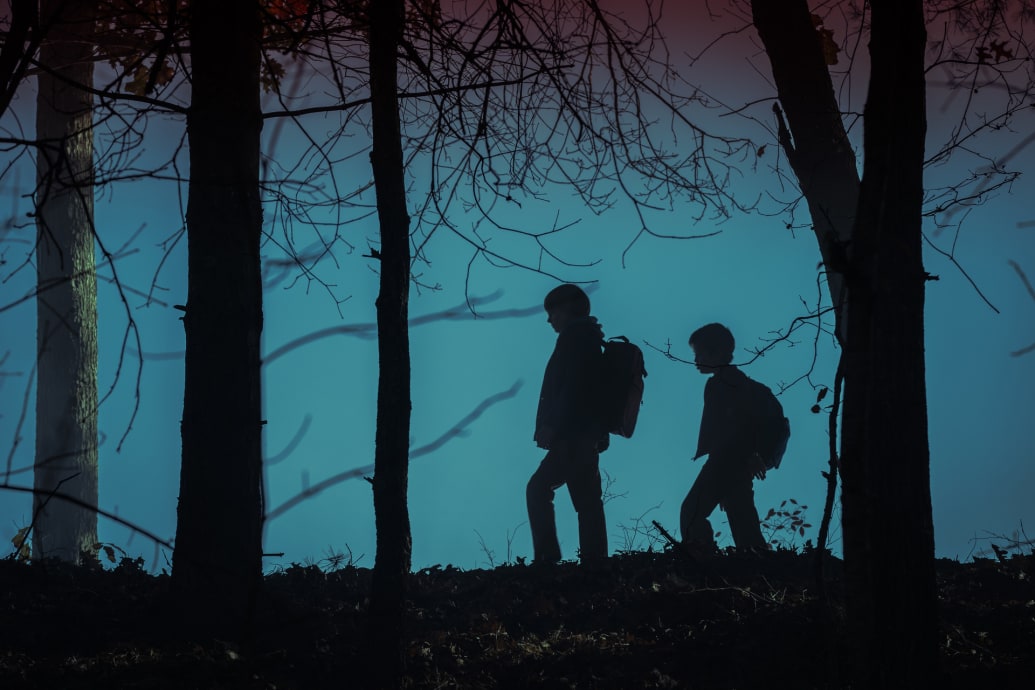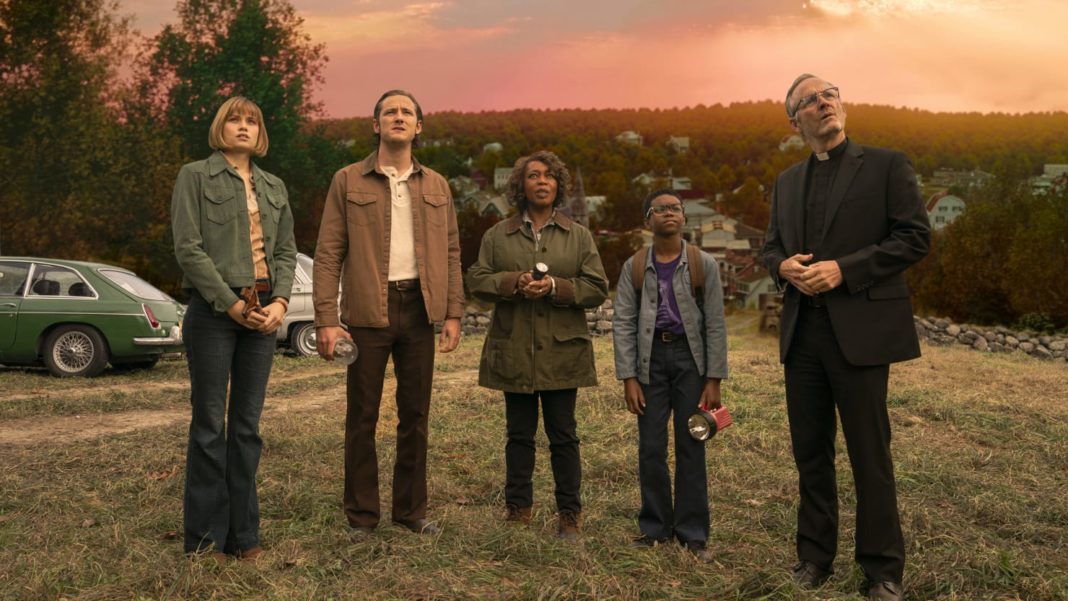Salem’s Lot is one of Stephen King’s best books, and though Tobe Hooper’s 1979 TV miniseries adaptation is an uneven creature of the night, it features one scene—of a young vampire trying to gain entry into a friend’s home via a second-floor bedroom window—that’s the stuff of nightmares. Writer/director Gary Dauberman’s new feature version of King’s classic tale restages that iconic moment to lesser results, if only because it lacks the eerie unnaturalness that made it so unforgettable. In most other respects, however, his film is a reasonably faithful and effective thriller, light on legitimate frights but polished and unnerving.
Despite sitting on the shelf for two years (for reasons that make little sense, given the finished product), Salem’s Lot, which premieres Oct. 3 on Max, is an assured spookshow about the Maine town of Jerusalem’s Lot, whose streets are overlooked by the creepy gothic Marsten House. It’s to that abode’s cobwebby cellar that, in 1976, two men haul an enormous crate on the orders of Richard Straker (Pilou Asbæk), a newly arrived businessman who’s opening an antiques shop. These frightened individuals never learn the true contents of this box, but it’s no secret that within it resides Kurt Barlow (Alexander Ward), a malevolent vampire who, it turns out, looks a lot like the Barlow of Hooper’s predecessor: pale bald head, maw full of fangs, long slender fingers with pointy nails, and eyes that glow in the dark.
Straker and Barlow’s appearance in “the Lot” coincides with the return of Ben Mears (Lewis Pullman), an author who lived there until the age of nine. Ben has come to research his new novel, although like his backstory, that motivation is thinner in Dauberman’s film than it was in King’s original. Such condensing occurs throughout Salem’s Lot, and yet the director does a solid job conjuring the look and feel of sleepy ’70s New England hamlets, where milk is delivered to doorsteps and kids on bikes toss newspapers onto front lawns. While it would have been nice if everyone’s hairstyle wasn’t so modern, the proceedings are suitably inviting, and bookending snippets of Gordon Lightfoot’s “Sundown” contribute to a chilling and enveloping mood.
Looking for a room to rent, Ben meets real estate agency secretary Susan Norton (Makenzie Leigh), with whom he shares immediate sparks, as well as many of the Lot’s other residents. That includes elementary school teacher Matthew Burke (Bill Camp), who’s introduced overseeing a fight involving new-kid-in-town Mark Petrie (Jordan Preston Carter), who earns the respect and friendship of brothers Danny (Nicholas Crovetti) and Ralph Glick (Cade Woodward) when he fights back against a bully.
Courtesy New Line Cinema/Max
Throughout the course of Salem’s Lot, they’re joined by additional characters, including Dr. Cody (Alfre Woodward), Sheriff Gillespie (William Sadler), and Father Callahan (John Benjamin Hickey), whose faith is almost as shaky as his hands become when he goes too long without a drink. With the same efficiency that defines his plotting, Dauberman defines all these players in brief, bold brushstrokes, making them believable personalities rather than just stock types.
Straker is Barlow’s human “familiar” (i.e. servant), and he begins the process of restoring his master to full power by kidnapping Ralph in a gorgeous forest sequence of striking silhouettes set against a dimming background. Dauberman and cinematographer Michael Burgess routinely find stylish ways to shoot their material (such as a quick cut from an opening Bible to the inside of a red jelly sandwich), employing mist, mirrors, and sinuous transitions to amplify tension. The filmmaker paces his mayhem as patiently as possible while jamming a lot of story into 113 minutes, and if that process comes at the expense of actual terror—and saps the proceedings of their despair—it also keeps things from dragging.

Courtesy New Line Cinema/Max
Ralph’s disappearance is followed by his sibling Danny’s death. Yet as gravedigger Mike Ryerson (Spencer Treat Clark) discovers, Danny isn’t deceased so much as undead. One by one, Barlow and Straker turn the Lot’s inhabitants into their bloodsucking minions, leaving Ben and his fellow survivors—initially Susan, Matthew, Dr. Cody, Father Callahan, and Mark—to figure out how to cope with this supernatural menace.
Salem’s Lot exists in a world in which people know about vampires, and thus crucifixes, holy water, and stakes are quickly wielded as weapons. Alas, those instruments aren’t enough to prevent many of them from perishing at the mouths of Barlow and his hungry followers, who stalk Ben outside the local church and surround Mark in his treehouse, begging for the boy to “come and play.”
Those fatalities should hit Ben and Mark much harder than they do in Salem’s Lot—a byproduct of the fact that Dauberman doesn’t have the time to linger on his characters’ emotional turmoil and grief. That renders the film more than a bit shallow. Even so, he makes up for it (to some extent) with sinister set pieces, including a finale set at a drive-in movie theater where the bill advertises a double feature of The Drowning Pool and Night Moves, and where the myriad dormant cars have become coffins for their nocturnal owners. Pullman doesn’t make much of an impression as Ben but he’s serviceable enough as a de facto protagonist. Camp and Woodard, on the other hand, are such charismatic and endearing presences that Matthew and Dr. Cody prove to be the most interesting of the saga’s many centers of attention.

Courtesy New Line Cinema/Max
Salem’s Lot invariably comes across as a SparkNotes rendition of King’s tome, merely hinting at some of its undercurrents, like the notion (articulated by Sheriff Gillespie) that the Lot is susceptible to Barlow’s evil because it already has one proverbial foot in the grave. Moreover, perhaps its biggest shortcoming is that, by never stopping to take a breath and deepen its portrait of Ben and his compatriots, it fails to provide a climactic emotional wallop. Still, it’s a formally elegant affair full of haunting images and faces, including that of Barlow, who materializes out of the shadows like a demon with red eyes and a jaw capable of expanding to monstrously wide dimensions. As with so much of the film’s particulars, he’s compelling and well-crafted, albeit spied too briefly to leave an indelible mark.


